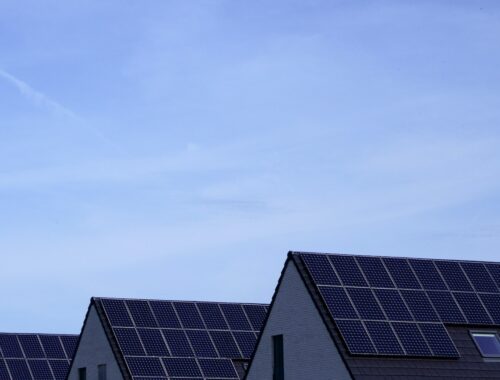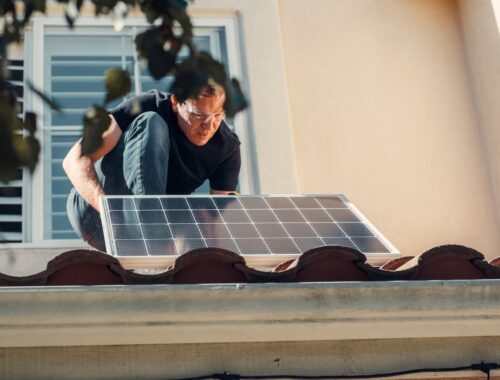
How exactly is electricity from solar energy produced?
Electricity from solar energy is produced through a process known as photovoltaics, which involves converting sunlight into electrical energy. This process takes place in solar cells, which are made up of materials that are capable of absorbing photons of light and converting them into electrical energy.
The basic building block of a solar cell is a material called a semiconductor, typically made of silicon. When sunlight hits the solar cell, photons of light are absorbed by the semiconductor, which excites electrons in the material and generates an electric current.
In order to turn this electrical energy into usable electricity, the solar cells are connected together to form a solar panel, or module. The electrical energy generated by the solar cells is then fed into an inverter, which converts the direct current (DC) electricity produced by the solar cells into alternating current (AC) electricity, which is the form of electricity that is used in homes and businesses.
The solar panels are typically installed on rooftops, walls, or even on the ground, and they are designed to face the sun in order to maximize the amount of sunlight they receive. The panels are typically angled so that they receive the most sunlight possible, and they are often mounted on a tracking system that allows them to follow the sun as it moves across the sky.
Once the electrical energy has been converted into usable electricity, it can be used in a variety of ways. It can be used to power homes and businesses, to charge electric vehicles, or to provide electricity to remote areas where access to the grid is limited.
In addition, the excess electricity generated by the solar panels can be fed back into the grid, providing a source of clean, renewable energy for others to use. This is known as net metering, and it allows homeowners and businesses to earn credits for the excess electricity they generate, which can be used to offset their energy bills.
It is worth mentioning that the technology of solar cells and solar panels is constantly improving, and there are many new developments in the field of solar energy that are making it an increasingly cost-effective and efficient source of electricity. For example, new materials and manufacturing processes are being developed that are making solar cells and panels more durable and efficient, and new technologies are being developed that are making it easier and more affordable to install and maintain solar energy systems.
It is also worth mentioning that the production of electricity from solar energy is a clean and renewable process. Unlike traditional sources of energy, such as fossil fuels, solar energy does not emit harmful pollutants into the atmosphere, and it does not contribute to climate change. This makes it a critical component in the effort to reduce greenhouse gas emissions and mitigate the impacts of climate change.
In addition, the use of solar energy can help to reduce the dependence on non-renewable energy sources, such as coal, oil, and natural gas, which are finite and becoming increasingly scarce. By using solar energy to generate electricity, we can help to conserve these finite resources for future generations, and reduce our dependence on non-renewable energy sources.
Another important aspect of the production of electricity from solar energy is its scalability. Solar panels can be installed on homes and businesses, or they can be installed in large-scale installations, such as solar farms, to generate significant amounts of electricity for entire communities, regions, or even countries. This scalability makes it an ideal source of energy for communities of all sizes, and it can be adapted to meet the unique energy needs of each community.
It is also worth mentioning that the production of electricity from solar energy has a positive impact on the economy. The growth of the solar energy industry is creating jobs and driving economic growth, and it is helping to support the development of new technologies and businesses. The use of solar energy can also reduce the cost of energy for homes and businesses, providing a more stable and predictable energy cost over time.
In addition, the use of solar energy can help to reduce the cost of energy for governments and utilities, improving energy security and reducing the need for expensive energy imports. This can free up resources that can be used for other important priorities, such as education, healthcare, and infrastructure development.
Another important aspect of the production of electricity from solar energy is its potential to improve energy access and reduce energy poverty. In many parts of the world, access to electricity is limited, and millions of people lack access to the energy they need to power their homes and businesses. The use of solar energy can help to provide access to electricity in these areas, improving quality of life and reducing poverty.
It is worth mentioning that the production of electricity from solar energy is a critical component in the transition to a more sustainable future. By using solar energy to generate electricity, we can help to reduce greenhouse gas emissions, conserve finite resources, and reduce our dependence on non-renewable energy sources. This can help to create a more sustainable future for everyone, with ample supplies of clean, renewable energy that can be used for generations to come.
It is worth mentioning that the production of electricity from solar energy is becoming increasingly cost-competitive with traditional sources of energy. As the technology of solar cells and solar panels continues to improve, and as the cost of solar energy continues to decrease, it is becoming an increasingly cost-effective and efficient source of energy. This is making it an increasingly popular choice for homes and businesses, and it is helping to drive the growth of the solar energy industry.
Electricity from solar energy is produced through a process known as photovoltaics, which involves converting sunlight into electrical energy. This process takes place in solar cells, which are made up of materials that are capable of absorbing photons of light and converting them into electrical energy. By connecting the solar cells together to form a solar panel, and by using an inverter to convert the direct current electricity produced by the solar cells into usable alternating current electricity, solar energy can be used to power homes, businesses, and communities, and to provide a clean, renewable source of energy for everyone.
You May Also Like

Is solar energy free?
April 21, 2023
How is solar energy more effective?
March 27, 2023

